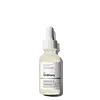What's inside
What's inside
 Key Ingredients
Key Ingredients

 Benefits
Benefits

 Concerns
Concerns

No concerns
 Ingredients Side-by-side
Ingredients Side-by-side

Water
Skin ConditioningSodium Hyaluronate
HumectantPropanediol
SolventPentylene Glycol
Skin ConditioningHydrolyzed Hyaluronic Acid
HumectantSodium Hyaluronate Crosspolymer
HumectantPhospholipids
Skin ConditioningSphingolipids
EmollientPanthenol
Skin ConditioningAhnfeltiopsis Concinna Extract
Skin ConditioningGlycerin
HumectantPolysorbate 20
EmulsifyingCitric Acid
BufferingSodium Citrate
BufferingP-Anisic Acid
MaskingTocopherol
AntioxidantTrisodium Ethylenediamine Disuccinate
Caprylyl Glycol
EmollientEthoxydiglycol
HumectantEthylhexylglycerin
Skin ConditioningHexylene Glycol
EmulsifyingPhenoxyethanol
PreservativeChlorphenesin
AntimicrobialWater, Sodium Hyaluronate, Propanediol, Pentylene Glycol, Hydrolyzed Hyaluronic Acid, Sodium Hyaluronate Crosspolymer, Phospholipids, Sphingolipids, Panthenol, Ahnfeltiopsis Concinna Extract, Glycerin, Polysorbate 20, Citric Acid, Sodium Citrate, P-Anisic Acid, Tocopherol, Trisodium Ethylenediamine Disuccinate, Caprylyl Glycol, Ethoxydiglycol, Ethylhexylglycerin, Hexylene Glycol, Phenoxyethanol, Chlorphenesin
Water
Skin ConditioningGlycerin
HumectantLactic Acid
BufferingOctyldodecyl Myristate
EmollientButylene Glycol
HumectantBis-PEG-18 Methyl Ether Dimethyl Silane
EmollientDimethicone
EmollientPPG-24-Glycereth-24
EmulsifyingSodium Hydroxide
BufferingHydrogenated Lecithin
EmulsifyingGlycereth-26
HumectantPolysorbate 80
EmulsifyingSodium Hyaluronate
HumectantCaffeine
Skin ConditioningAloe Barbadensis Leaf Water
MaskingC13-14 Isoparaffin
EmollientSodium Polyaspartate
HumectantTrehalose
HumectantSodium Stearoyl Glutamate
CleansingGlycyrrhetinic Acid
Skin ConditioningSucrose
HumectantLaureth-7
EmulsifyingXanthan Gum
EmulsifyingDimethicone/PEG-10/15 Crosspolymer
Polyacrylamide
Tocopheryl Acetate
AntioxidantMagnesium Ascorbyl Phosphate
AntioxidantBHT
AntioxidantDisodium EDTA
Phenoxyethanol
PreservativePotassium Sorbate
PreservativeMica
Cosmetic ColorantCI 77891
Cosmetic ColorantCI 77491
Cosmetic ColorantWater, Glycerin, Lactic Acid, Octyldodecyl Myristate, Butylene Glycol, Bis-PEG-18 Methyl Ether Dimethyl Silane, Dimethicone, PPG-24-Glycereth-24, Sodium Hydroxide, Hydrogenated Lecithin, Glycereth-26, Polysorbate 80, Sodium Hyaluronate, Caffeine, Aloe Barbadensis Leaf Water, C13-14 Isoparaffin, Sodium Polyaspartate, Trehalose, Sodium Stearoyl Glutamate, Glycyrrhetinic Acid, Sucrose, Laureth-7, Xanthan Gum, Dimethicone/PEG-10/15 Crosspolymer, Polyacrylamide, Tocopheryl Acetate, Magnesium Ascorbyl Phosphate, BHT, Disodium EDTA, Phenoxyethanol, Potassium Sorbate, Mica, CI 77891, CI 77491
 Reviews
Reviews

Ingredients Explained
These ingredients are found in both products.
Ingredients higher up in an ingredient list are typically present in a larger amount.
Glycerin is already naturally found in your skin. It helps moisturize and protect your skin.
A study from 2016 found glycerin to be more effective as a humectant than AHAs and hyaluronic acid.
As a humectant, it helps the skin stay hydrated by pulling moisture to your skin. The low molecular weight of glycerin allows it to pull moisture into the deeper layers of your skin.
Hydrated skin improves your skin barrier; Your skin barrier helps protect against irritants and bacteria.
Glycerin has also been found to have antimicrobial and antiviral properties. Due to these properties, glycerin is often used in wound and burn treatments.
In cosmetics, glycerin is usually derived from plants such as soybean or palm. However, it can also be sourced from animals, such as tallow or animal fat.
This ingredient is organic, colorless, odorless, and non-toxic.
Glycerin is the name for this ingredient in American English. British English uses Glycerol/Glycerine.
Learn more about GlycerinPhenoxyethanol is a preservative that has germicide, antimicrobial, and aromatic properties. Studies show that phenoxyethanol can prevent microbial growth. By itself, it has a scent that is similar to that of a rose.
It's often used in formulations along with Caprylyl Glycol to preserve the shelf life of products.
Sodium Hyaluronate is hyaluronic acid's salt form. It is commonly derived from the sodium salt of hyaluronic acid.
Like hyaluronic acid, it is great at holding water and acts as a humectant. This makes it a great skin hydrating ingredient.
Sodium Hyaluronate is naturally occurring in our bodies and is mostly found in eye fluid and joints.
These are some other common types of Hyaluronic Acid:
Learn more about Sodium HyaluronateWater. It's the most common cosmetic ingredient of all. You'll usually see it at the top of ingredient lists, meaning that it makes up the largest part of the product.
So why is it so popular? Water most often acts as a solvent - this means that it helps dissolve other ingredients into the formulation.
You'll also recognize water as that liquid we all need to stay alive. If you see this, drink a glass of water. Stay hydrated!
Learn more about Water